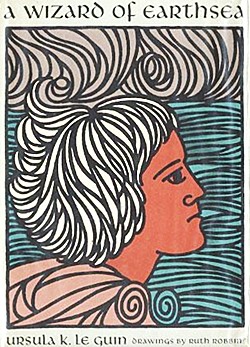
A Wizard of Earthsea is a fantasy novel written by American author Ursula K. Le Guin and first published by the small press Parnassus in 1968. It is regarded as a classic of children's literature and of fantasy, within which it is widely influential. The story is set in the fictional archipelago of Earthsea and centers on a young mage named Ged, born in a village on the island of Gont. He displays great power while still a boy and joins a school of wizardry, where his prickly nature drives him into conflict with a fellow student. During a magical duel, Ged's spell goes awry and releases a shadow creature that attacks him. The novel follows Ged's journey as he seeks to be free of the creature.

Ursula Kroeber Le Guin was an American author. She is best known for her works of speculative fiction, including science fiction works set in her Hainish universe, and the Earthsea fantasy series. Her work was first published in 1959, and her literary career spanned nearly sixty years, producing more than twenty novels and over a hundred short stories, in addition to poetry, literary criticism, translations, and children's books. Frequently described as an author of science fiction, Le Guin has also been called a "major voice in American Letters". Le Guin said she would prefer to be known as an "American novelist".

The Dispossessed is a 1974 anarchist utopian science fiction novel by American writer Ursula K. Le Guin, one of her seven Hainish Cycle novels. It is one of a small number of books to win all three Hugo, Locus and Nebula Awards for Best Novel. It achieved a degree of literary recognition unusual for science fiction due to its exploration of themes such as anarchism and revolutionary societies, capitalism, utopia, individualism, and collectivism.
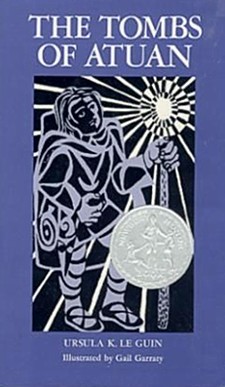
The Tombs of Atuan is a fantasy novel by the American author Ursula K. Le Guin, first published in the Winter 1970 issue of Worlds of Fantasy, and published as a book by Atheneum Books in 1971. It is the second book in the Earthsea series after A Wizard of Earthsea (1969). The Tombs of Atuan was a Newbery Honor Book in 1972.
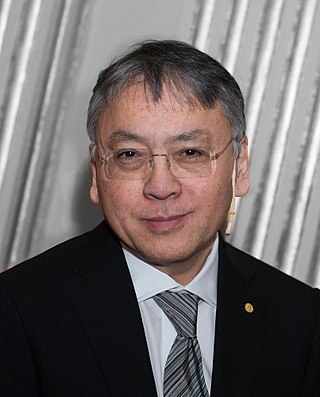
Sir Kazuo Ishiguro is a Japanese-born British novelist, screenwriter, musician, and short-story writer. He is one of the most critically acclaimed contemporary fiction authors writing in English, having been awarded the 2017 Nobel Prize in Literature. In its citation, the Swedish Academy described Ishiguro as a writer "who, in novels of great emotional force, has uncovered the abyss beneath our illusory sense of connection with the world".

Gawain, also known in many other forms and spellings, is a character in Arthurian legend, in which he is King Arthur's nephew and one of the premier Knights of the Round Table. The prototype of Gawain is mentioned under the name Gwalchmei in the earliest Welsh sources. He has subsequently appeared in many Arthurian tales in Welsh, Latin, French, English, Scottish, Dutch, German, Spanish, and Italian, notably as the protagonist of the Middle English poem Sir Gawain and the Green Knight. Other works featuring Gawain as their central character include De Ortu Waluuanii, Diu Crône, Ywain and Gawain, Golagros and Gawane, Sir Gawain and the Carle of Carlisle, L'âtre périlleux, La Mule sans frein, La Vengeance Raguidel, Le Chevalier à l'épée, Le Livre d'Artus, The Awntyrs off Arthure, The Greene Knight, and The Weddynge of Syr Gawen and Dame Ragnell.

The Earthsea Cycle, also known as Earthsea, is a series of high fantasy books written by the American author Ursula K. Le Guin. Beginning with A Wizard of Earthsea (1968), The Tombs of Atuan, (1970) and The Farthest Shore (1972), the series was continued in Tehanu (1990), and Tales from Earthsea and The Other Wind. In 2018, all the novels and short stories were published in a single volume, The Books of Earthsea: The Complete Illustrated Edition, with artwork by Charles Vess.

Tehanu, initially subtitled The Last Book of Earthsea, is a fantasy novel by the American author Ursula K. Le Guin, published by Atheneum in February 1990. It is the fourth novel set in the fictional archipelago Earthsea, published almost twenty years after the first three Earthsea novels (1968–1972), and not the last, despite its original subtitle.

Rocannon's World is a science fiction novel by American writer Ursula K. Le Guin, her literary debut. It was published in 1966 as an Ace Double, along with Avram Davidson's The Kar-Chee Reign, following the tête-bêche format. Though it is one of Le Guin's many works set in the universe of the technological Hainish Cycle, the story itself has many elements of heroic fantasy. The hero Gaveral Rocannon encounters lords who live in castles and wield swords, and other races much like fairies and gnomes, in his travels on a backward planet.

City of Illusions is a 1967 science fiction novel by American writer Ursula K. Le Guin. It is set on Earth in the distant future, and is part of her Hainish Cycle. City of Illusions lays the foundation for the Hainish cycle which is a fictional universe in which the majority of Ursula K. Le Guin's science fiction novels take place.
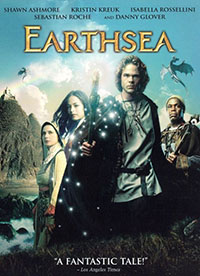
Legend of Earthsea is a two-part television fantasy miniseries produced for the Sci-Fi Channel and aired in 2004. It is an adaptation of the Earthsea novels by Ursula K. Le Guin. The teleplay was written by Gavin Scott, and the series was directed by Robert Lieberman. Legend of Earthsea is an American-Canadian co-production that was filmed on location in Vancouver, British Columbia.

An Artist of the Floating World (1986) is a novel by British author Kazuo Ishiguro. It is set in post-World War II Japan and is narrated by Masuji Ono, an ageing painter, who looks back on his life and how he has lived it. He notices how his once-great reputation has faltered since the war and how attitudes towards him and his paintings have changed. The chief conflict deals with Ono's need to accept responsibility for his past actions, rendered politically suspect in the context of post-War Japan. The novel ends with the narrator expressing good will for the young white-collar workers on the streets at lunchbreak. The novel also deals with the role of people in a rapidly changing political environment and with the assumption and denial of guilt.

The Left Hand of Darkness is a science fiction novel by the American writer Ursula K. Le Guin. Published in 1969, it became immensely popular, and established Le Guin's status as a major author of science fiction. The novel is set in the fictional Hainish universe as part of the Hainish Cycle, a series of novels and short stories by Le Guin, which she introduced in the 1964 short story "The Dowry of Angyar". It was fourth in sequence of writing among the Hainish novels, preceded by City of Illusions, and followed by The Word for World Is Forest.

Ursula K. Le Guin (1929–2018) was an American author of speculative fiction, realistic fiction, non-fiction, screenplays, librettos, essays, poetry, speeches, translations, literary critiques, chapbooks, and children's fiction. She was primarily known for her works of speculative fiction. These include works set in the fictional world of Earthsea, stories in the Hainish Cycle, and standalone novels and short stories. Though frequently referred to as an author of science fiction, critics have described her work as being difficult to classify.
Ged is the true name of a fictional character in Ursula K. Le Guin's Earthsea realm. He is introduced in A Wizard of Earthsea, and plays both main and supporting roles in the subsequent Earthsea novels. In most of the Earthsea books he goes by the Hardic name Sparrowhawk; as a child he is known as Duny.

Gifts (2004) is a young adult fantasy novel by Ursula K. Le Guin. It is the first book in the Annals of the Western Shore trilogy, and is followed in the series by Voices. The story is set in a fictional world, in a barren and poverty-stricken region called the Uplands, some of whose inhabitants have hereditary magical gifts. The story follows the narrator Orrec, son of the leader of the domain of Caspromant, whose hereditary gift is the ability to "unmake", and Gry, the daughter of a neighboring domain, who can communicate with animals. Orrec's gift manifests late, and seems uncontrollable, and so he is blindfolded. Their families are caught up in the cycle of violent feuds and retribution that characterize Upland society in which the children are trying to find their place.
The impression of depth in The Lord of the Rings is an aesthetic effect deliberately sought by its author, J. R. R. Tolkien. It was intended to give the reader the feeling that the work had "deep roots in the past", and hence that it was attractively authentic.

The 2017 Nobel Prize in Literature was awarded to the British novelist Kazuo Ishiguro "who, in novels of great emotional force, has uncovered the abyss beneath our illusory sense of connection with the world." The prize was announced by the Swedish Academy on 5 October 2017.
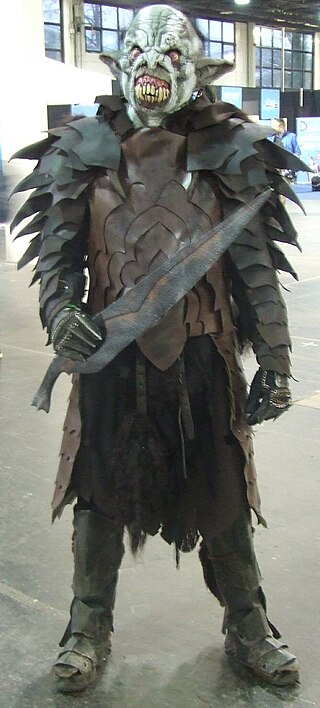
Although fantasy had long existed in various forms around the world before his time, J. R. R. Tolkien has been called the "father of fantasy", and The Lord of the Rings its centre. That novel, published in 1954–5, enormously influenced fantasy writing, establishing in particular the form of high or epic fantasy, set in a secondary or fantasy world in an act of mythopoeia. The book was distinctive at the time for its considerable length, its "epic" feel with a cast of heroic characters, its wide geography, and its battles. It involved an extensive history behind the action, an impression of depth, multiple sentient races and monsters, and powerful talismans. The story is a quest, with multiple subplots. The novel's success demonstrated that the genre was commercially distinct and viable.















